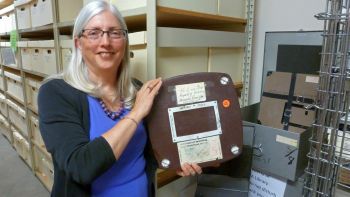
Publisher:
Bonnie King
CONTACT:
Newsroom@Salem-news.com
Advertising:
Adsales@Salem-news.com

~Truth~
~Justice~
~Peace~
TJP
Jun-06-2014 08:40

 TweetFollow @OregonNews
TweetFollow @OregonNews
Films of Early Years of Hydroelectric Power in The Northwest Recovered
Salem-News.comSo far, the BPA Library has mailed more than 1,800 copies to people all over the region.
 The Bonneville Power Administration Library has released a new collection of six BPA produced films from the 1930s, '40s and '50s that takes viewers on a cinematic journey into the early years of the Northwest hydroelectric power and transmission systems. |
(PORTLAND, Ore. ) - The Bonneville Power Administration Library has released a new collection of six BPA produced films from the 1930s, '40s and '50s that takes viewers on a cinematic journey into the early years of the Northwest hydroelectric power and transmission systems.
The DVD set, titled "BPA Film Collection Volume 1, 1939-1954," is the first compilation of films from the agency's archives ever made available. And it has received a warm reception.
"The series forms a composite portrait of the river - a forceful, magnetic, photogenic presence - and of the people who spent their lives attempting to tame it," says Anne Richardson, host of the Oregon Movies, A to Z website. For regional historian and filmmaker Ellie Belew, they are a captivating introduction for those who want to begin to understand the management of the Columbia River Basin. "These DVDs bring to life not only the actual build-out of regional infrastructure, but also the attitudes and assumptions that supported development of publicly owned power utilities in the Pacific Northwest," Belew observes.
Since the DVD's release in January, the BPA Library has been flooded with requests.
"We handed out 500 copies in the first five days," says librarian Libby Burke, a film archivist with a degree in cinema studies who curated the DVD collection.
So far, the BPA Library has mailed more than 1,800 copies to people all over the region.
"We've received requests from as far away as Alna, Maine; Amherst, Massachusetts; and Tempe, Arizona," Burke says. "And we even mailed a copy to the "Big Quonset Hut" at Grand Coulee Dam."
While the films chronicle the origins of electric power in the region, it turns out the story behind the collection is also one of discovery.
Twenty years ago, BPA transferred its 16-millimeter films to videotape. But last winter when Burke began preparing for a film festival, the original prints were missing from the BPA archives and presumed discarded or even destroyed. But in a rare twist, much to the surprise of Burke, the National Archives and Records Administration discovered eight storage boxes with 50 reels of BPA films in cold storage in Seattle.
"We were genuinely shocked," she says. "Every once in a while, a lost film is found, but you don't usually get back an entire collection of original prints. It's like a miracle."
And the timing couldn't have been better. With the return of the lost films just weeks before the planned release of the collection, BPA postponed distribution in order to provide clean, digital transfers from the originals of the six films featured in the DVD set.
Burke says the condition of the originals was light years better than the 20-year-old videotape transfers. "The new transfers look beautiful," she says. "The improved detail, color and sound complement the true quality and value of these special films."
The new collection includes three of the most notable films made by BPA: "Hydro" (1939), the first film produced by BPA's motion-picture division; "The Columbia: America's Greatest Power Stream" (1949), the most famous BPA-produced film, containing songs Woody Guthrie wrote while employed by BPA; and "Highline" (1950), about the building of the Northwest's high-voltage electric transmission system.
It also showcases three films about the Columbia River power system and the Pacific Northwest in transition: "Power Builds Ships" (1942), about how the ship-building industry in the Northwest helped win World War II; "25,000 Volts Under the Sea" (1952), about the remarkable design, transport and laying of the underwater high-voltage cable that electrified Washington's San Juan Islands; and "Look to the River" (1954), a rather impressionistic color film about the expansion of the dam system, with a score by Oscar-winning composer Ernest Gold. As a bonus, the set includes a booklet of movie posters and photographs, as well as introductions by Burke, who offers insight to the films on each disc.
Viewers should be aware that the films portray the populist perspective of the period, which predates some of the cultural and environmental sensitivities of today. "These films were made at a time when those issues weren't traditionally considered," Burke explains. "The primary considerations were economic development and promoting public power. But with that in mind, we should still appreciate the history and purpose of these films."
Source: BPA
 |
Articles for June 5, 2014 | Articles for June 6, 2014 | Articles for June 7, 2014



Quick Links
DINING
Willamette UniversityGoudy Commons Cafe
Dine on the Queen
Willamette Queen Sternwheeler
MUST SEE SALEM
Oregon Capitol ToursCapitol History Gateway
Willamette River Ride
Willamette Queen Sternwheeler
Historic Home Tours:
Deepwood Museum
The Bush House
Gaiety Hollow Garden
AUCTIONS - APPRAISALS
Auction Masters & AppraisalsCONSTRUCTION SERVICES
Roofing and ContractingSheridan, Ore.
ONLINE SHOPPING
Special Occasion DressesAdvertise with Salem-News
Contact:AdSales@Salem-News.com

Terms of Service | Privacy Policy
All comments and messages are approved by people and self promotional links or unacceptable comments are denied.
[Return to Top]
©2025 Salem-News.com. All opinions expressed in this article are those of the author and do not necessarily reflect those of Salem-News.com.